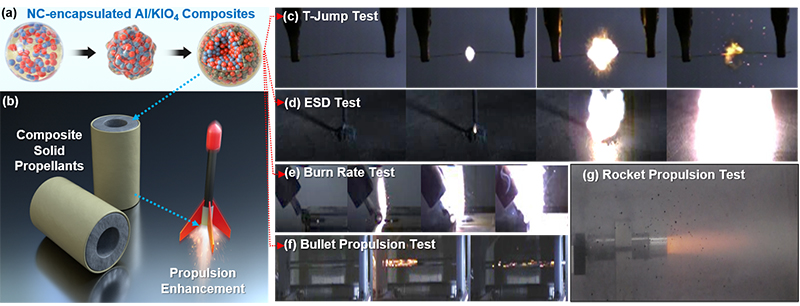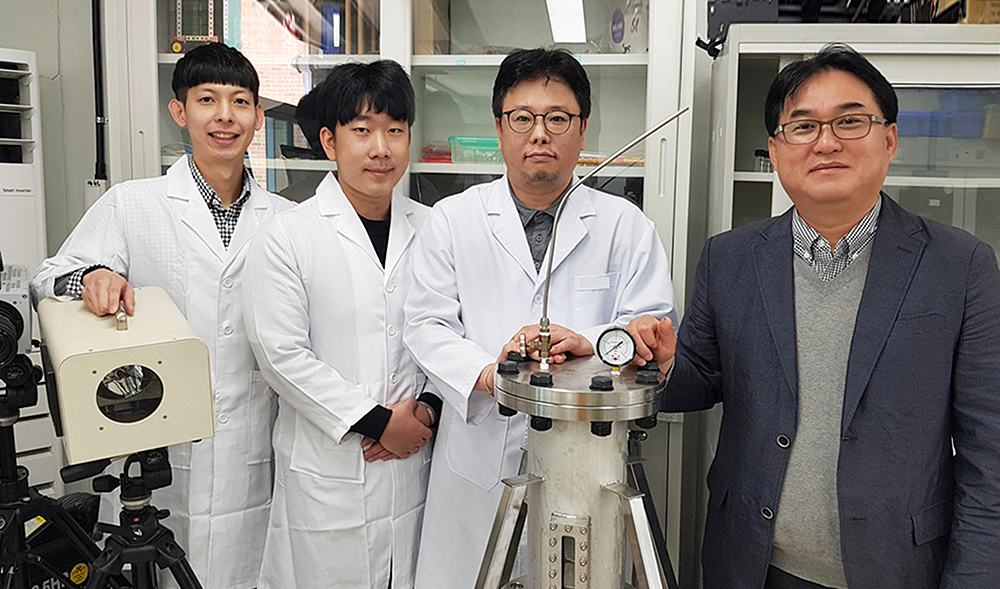- 게시일자
- 조회수
- 391
[PNU리서치] 김수형 교수팀, 기능성 '나노고에너지물질' 폭발 위험 줄이고 효율 증진
‘고에너지물질(Energetic Materials)’은 보통 금속과 산화제 물질로 구성돼 내부에 화학에너지를 담고 있으면서 점화 시 급격하게 자가 연소해 열과 압력을 방출하는 기능성 물질이다. 특히, 나노스케일의 고에너지물질을 구현할 경우 반응성이 증대돼 점화 시 연소열과 압력의 방출량이 매우 짧은 시간에 급격하게 증가하기 때문에 기존의 벌크 및 마이크로스케일 고에너지물질의 연소 및 폭발 특성을 향상시킬 수 있는 획기적인 기술로 상용화에 대한 기대가 매우 높다.
나노에너지공학과 김수형 교수팀은 알루미늄(Al) 나노입자와 과요오드산 칼륨(KIO₄) 나노입자를 기반으로 하는 나노고에너지물질의 표면을 니트로셀룰로스(Nitrocellulose)와 같은 에너제틱 폴리머로 코팅함으로써 외부 충격으로부터 보호할 수 있는 보호막을 형성해 안정성을 높이고, 이를 전통적인 고체추진제에 적용함으로써 연소실 내에서 점화 시 높은 연소열과 압력을 유도해 소형발사체의 추진력을 최종적으로 향상시킬 수 있는 원천기술 개발에 성공했다.
산업용 및 군용 열공학 분야에 많이 활용되는 나노고에너지물질은 외부의 자극 및 충격 등에 매우 민감해 뜻하지 않은 폭발이 일어나는 경우가 많아 극히 제한된 전문가만이 취급할 수 있는데, 이러한 제한된 응용성을 넓히기 위해 연구팀은 나노고에너지물질의 표면에 균일하게 폴리머 보호막 코팅을 할 수 있는 기체상 에어로졸 공정을 개발했다.

(a, b) 나노고에너지물질 기체상 성장 메커니즘 및 나노고에너지물질이 적용된 고체추진제의 로켓 소형발사체 응용 개요도.
기체상 에어로졸 공정을 통해 생성된 나노고에너지물질의 (c) 점화 테스트, (d) 정전스파크 인가 안정성 테스트
(e) 연소율 측정 테스트, (f) 탄환형 소형발사체 추진 테스트, (g) 로켓형 소형발사체 추진 테스트 과정 사진.
이러한 에어로졸 공정 내에서 나노스케일의 금속, 산화제, 폴리머의 구성비를 다양하게 변화시키면서 관찰한 결과, 나노고에너지물질의 안정성을 높이면서 동시에 이들을 기반으로 하는 고체추진제의 연소 및 추진 특성을 극대화해 최종적으로 소형발사체의 추진력을 향상시킬 수 있는 방안을 실험적으로 구현한 것이다.
이번 연구는 방위사업청 및 국방과학연구소에서 지원하는 국방순수기초연구사업과 교육부에서 지원하는 지역우수과학자사업을 통해 수행됐으며, 재료 및 화학공학 분야 국제학술지인 『케미컬 엔지니어링 저널(Chemical Engineering Journal)』에 온라인 4월 22일자로 게재됐다.
- 논문 제목: Effect of Energetic Polymer Encapsulation for Aluminum/Potassium Periodate-based Composites on Ignition Sensitivity and Combustion Characteristics(점화 감도 및 연소 특성에 대한 알루미늄/과요오드산 칼륨 기반 복합체의 에너제틱 폴리머 캡슐화 효과)
- 논문 링크: https://doi.org/10.1016/j.cej.2022.136519
* 연구자 사진: 오른쪽부터 김수형 교수(교신저자), 김호성 박사(제1저자), 조현수·차정근 석사과정생(공동저자)
[Abstract]
Energetic composites composed of metal and oxidizer are limitedly employed in thermal engineering systems due to their sensitivity. Therefore, energetic polymer encapsulation can be suggested as a method of protecting energetic composites from unexpected external stimuli, as well as maintaining relatively high explosive reactivity. In this study, the effect of nitrocellulose (NC; polymer) encapsulation on the ignition and combustion characteristics of aluminum (Al; fuel)/potassium periodate (KIO₄; oxidizer) energetic composites is systematically examined. NC-encapsulated Al/KIO₄ energetic composites are manufactured using a spray drying method, which enables uniform mixing of Al nanoparticles (NPs) with KIO₄ NPs in the NC matrix. As the more NC encapsulation is made on Al/KIO4 energetic composites, the ignition delay time and ignition threshold spark energy increase, suggesting a reduction in the sensitivity of the energetic composites. However, the maximum pressure and pressurization rates of NC-encapsulated Al/KIO4 energetic composites ignited in a closed cell are higher when the NC content is below 10 wt.%, and then they considerably decrease with excessive NC content (>10 wt.%). On the basis of propulsion tests, the kinetic energy of bullet-type projectiles and specific impulses of small rocket-type projectiles charged with NC content of 5?10 wt.% in the Al/KIO4 energetic composites are two times higher than the values for Al/KIO4 energetic composites with no NC content. These results prove that the optimized polymer encapsulation is highly beneficial for developing various functional energetic composites and composite solid propellants, with compromised sensitivity and explosive reactivity, for enhancing the propulsion of small projectiles.
* Paper Title: Effect of Energetic Polymer Encapsulation for Aluminum/Potassium Periodate-based Composites on Ignition Sensitivity and Combustion Characteristics
- https://doi.org/10.1016/j.cej.2022.136519
* First Authors: Ji Hoon Kim & Ho Sung Kim (Research Center for Energy Convergence Technology, Pusan National University)
* Corresponding Author: Soo Hyung Kim (Department of Nanoenergy Engineering, Pusan National University)
- 첨부파일
- 첨부파일이(가) 없습니다.
